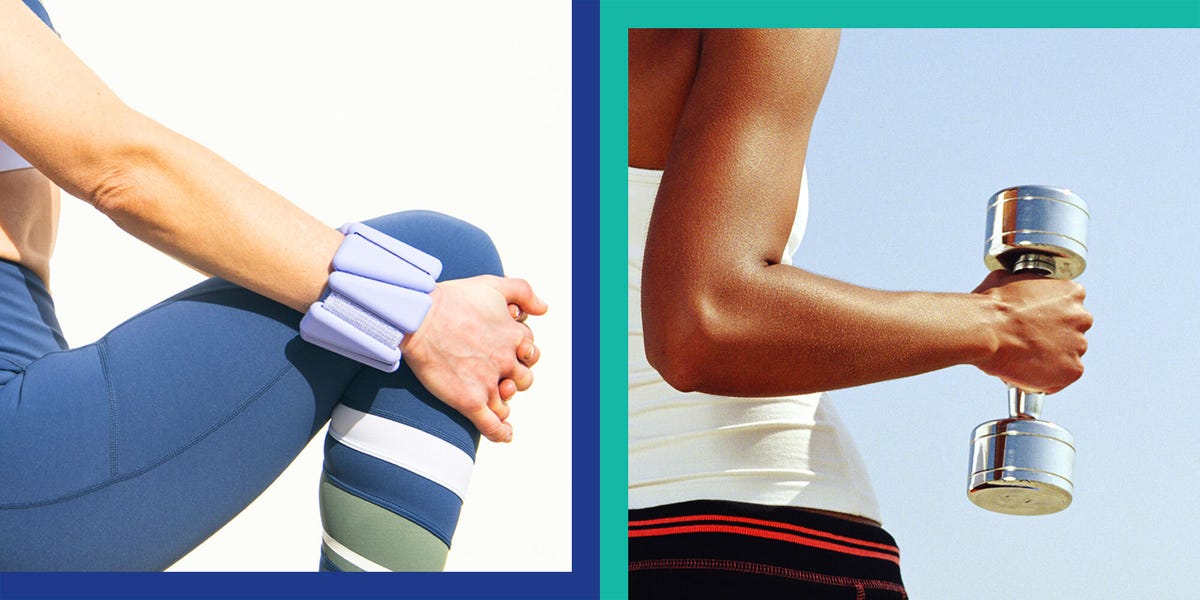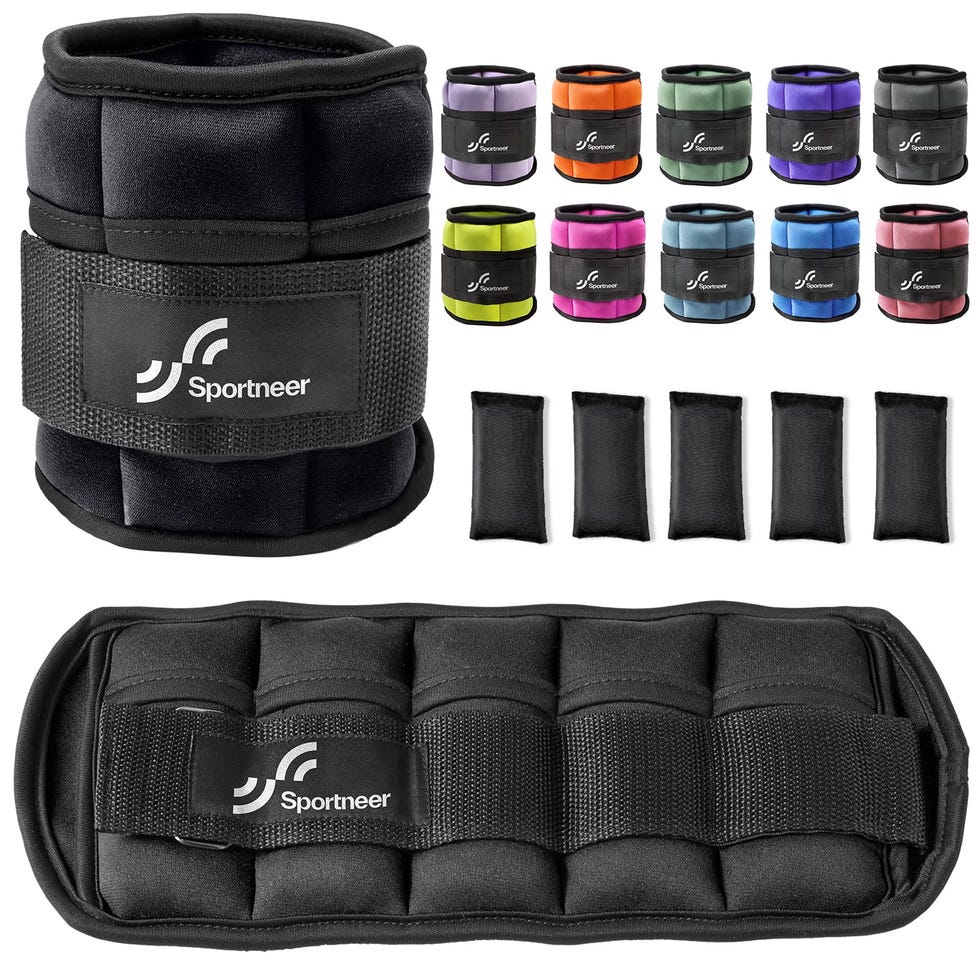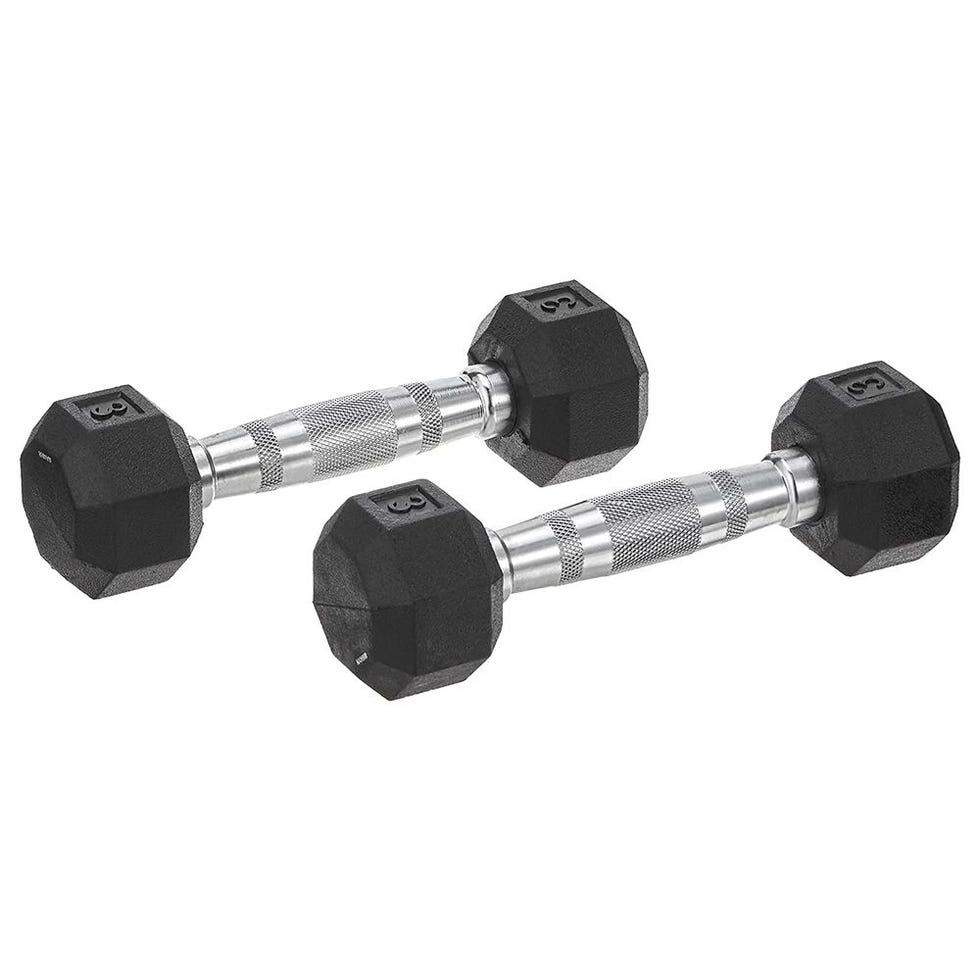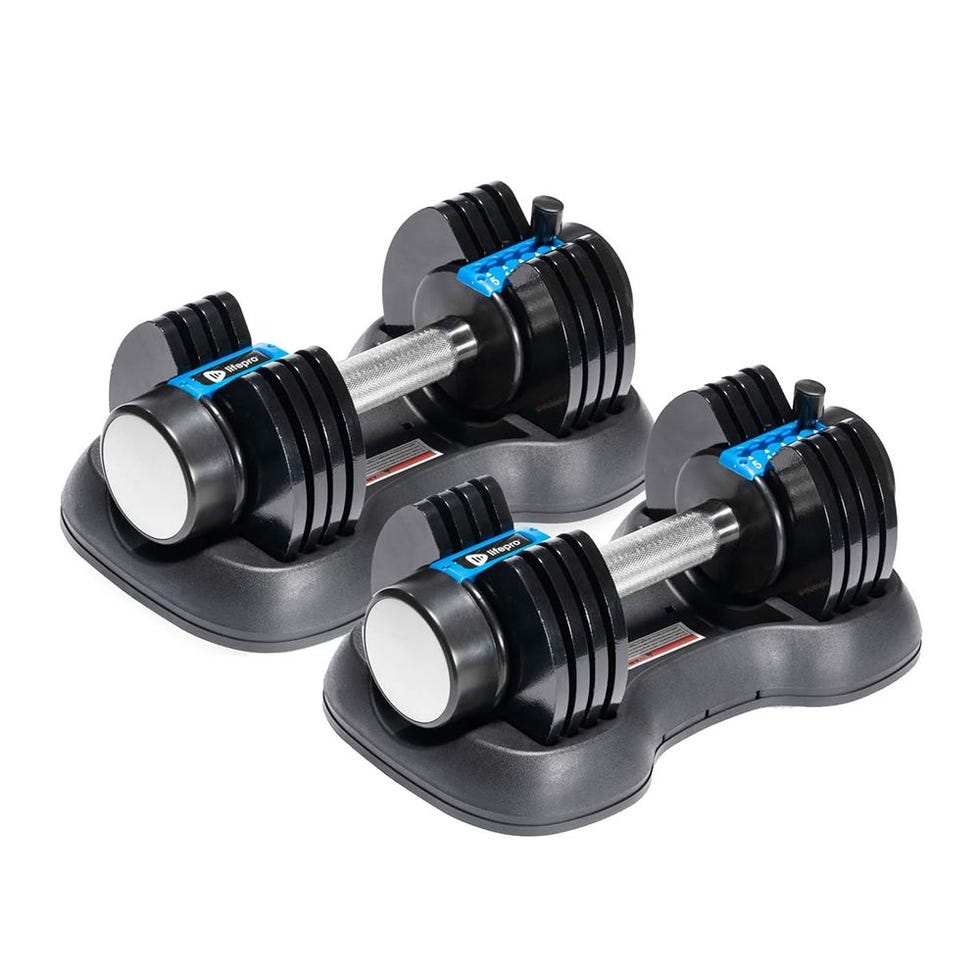If you’ve been on FitTok lately, you may have noticed a big resurgence of a popular workout tool from the 70s and 80s on your feed: wrist weights. While your mom and Jane Fonda slipped on wrist weights back then to up the ante in cardio classes, today, exercisers are wearing them in a myriad of ways to achieve sculpted arms (like during pilates, on long walks, and even…blow-drying their hair).
Wrist weights seem like a pretty sweet deal: They’re made to slide on (and stay secure), so you can maneuver your hands freely while still pushing your muscles against resistance. That helps them stand out against pretty much every other upper-body workout tool you can think of, including dumbbells, which require you to manually grip the weight.
Of course, if you own a pair, you might wonder if you can ditch dumbbells completely and rely solely on wrist weights to strengthen and sculpt your arms.
But neither tool is a one-size-fits-all solution, according to fitness coach Steven Haahr, CPT. Both types of resistance serve different purposes, and depending on what your fitness goals are, you might prefer one over the other, he says. Below, Haahr breaks down the differences between wrist weights and dumbbells—and how to choose between the two, depending on your workouts and goals.
Meet the expert: Steven Haahr, CPT, is a personal trainer with Equinox, TeamExos, LIT Method, and Get Active & Fit.
Wrist Weights Vs. Dumbbells: When To Use Each
Both wrist weights and dumbbells can have a place in your strength training toolkit, according to Haahr. What might push you to reach for either will depend largely on your fitness goals, he says.
Here’s a quick breakdown on the resistance type of each, and what fitness goals it’s suited for.
When And Why To Reach For Wrist Weights
The first—and primary—benefit of wrist weights? Freedom. “Wearable weights allow for more fluid, dynamic movement options,” says Haahr. You can move your limbs freely and naturally—all while continuing to apply resistance to your muscles and bones, which can help build muscular endurance, or your muscles’ ability to resist fatigue over time, per the American Council on Exercise (ACE). Here’s what the tool is best suited for:
- Low-impact and/or beginner movement. Wrist weights offer a low-impact strength training modality because “they don’t require gripping” and produce less strain on the elbow and wrist joints, says Haahr. “Because they allow more fluid, dynamic movement, wrist weights can be gentler on joints during high-repetition activities—though proper form and recovery are still essential to avoid overuse injuries.” Wrist weights are also “a great way to gently and gradually level up to bodyweight movements,” he says.
- Grip-free resistance for those with injuries or limited strength. The vast, vast majority of strength training tools require a certain amount of grip strength, which can be limiting for older individuals or those with wrist or hand injuries that might put too much stress on the joints. Wrist weights take grip strength out of the equation (a con, for some), allowing users to add resistance to upper body movements, hands-free.
- Fast-paced cardio or rhythmic forms of exercise. “Wrist weights can be a good option for longer duration, faster-paced workouts, like boxing, dancing, barre, and some forms of mat pilates—as they don’t restrict movement to the degree hand-held weights might,” Haahr says.
When And Why To Reach For Dumbbells
Dumbbells might not have the freedom of motion that wrist weights do, but that doesn’t make them any less versatile, Haahr says. “The load, or weight used, is obviously much wider and provides the potential for greater strength gains when heavier weights are used,” he says. Here’s exactly what (and who) dumbbells are best for:
- Increasing grip strength. Though gripping a weight might not be ideal for someone with an injury, if you’re otherwise healthy, you *need* to focus on grip strength—something dumbbells provide that wrist weights don’t. A 2024 Scientific Reports study found that decreased grip strength in adults was directly tied to early mortality.
- Focusing on unilateral movements and building small muscles. “Because they need to be held directly, dumbbells can engage many of the body’s smaller stabilizing muscles, especially during unilateral movements or exercises that challenge balance,” Haahr says. (Think: reverse lunges with dumbbells and/or single-leg romanian deadlifts.)
- Lifting heavier loads. Of course, the biggest benefit of dumbbells versus wrist weights is the ability to lift more, says Haahr. “When compared to wrist weights, dumbbells are better suited for traditional strength training, allowing for progressive overload and targeting specific muscle groups with higher resistance,” he says.
Which is better for strength and muscle gains?
When it comes to building real strength and muscle, dumbbells are the clear winner. “Dumbbells are far more effective [than wrist weights] both for building strength and for hypertrophy,” says Haahr.
For Building Muscle Size
To build visible muscle, you need enough stimulus to fatigue your muscles in the eight to 12 rep range, Haahr says. That means using a weight that actually challenges you—something most wrist weights simply don’t provide.
“Wrist weights are limited in load, so while they can add some resistance, they won’t offer the progressive overload needed for meaningful hypertrophy,” he says. You’d have to wear them for long stretches or during high-volume sessions to get close—and even then, progress may plateau quickly.
Dumbbells, on the other hand, let you scale up resistance over time, which is key to muscle growth.
FYI: Lifting heavy dumbbells won’t make you look like Popeye. In fact, strength training with heavy loads is one of the best methods for burning fat, per 2022 research from Sports Medicine. You’ll also reap more bone density benefits when you lift heavier loads, according to 2023 research from Frontiers in Physiology.
For Building Strength
If your goal is to get stronger (think: lift heavier, push more weight), the ideal rep range is even lower—three to six reps at a time with heavy, challenging loads.
“You need to be pushing your max capacity,” says Haahr. That kind of heavy resistance just isn’t possible with wearable weights, which top out at a few pounds per limb. Dumbbells allow you to safely load up, push yourself, and build power while targeting specific muscle groups.
For Building Muscular Endurance
That’s not to say wrist weights don’t have their place—especially when it comes to muscular endurance and what many people casually call “toning.”
“Wrist weights are lighter, offer a constant, more evenly distributed resistance, and are gentler on joints,” says Haahr. This makes them ideal for high-rep, low-load training (think 15+ reps per set, according to research from the journal Sports) where the goal is to improve endurance and create subtle muscle definition over time.
“While ‘toning’ isn’t a scientific term,” Haahr says, “it’s commonly used to describe a combination of building lean muscle and reducing body fat so that definition becomes more visible.” Wrist weights can help support that goal—when paired with proper nutrition and a well-rounded training program.
The Best Wrist Weights And Dumbbells To Shop For
Though wrist weights and dumbbells vary in terms of their benefits, there’s one thing they have in common: Each item is easy to store and use at home. Here are a few hand-picked faves from Women’s Health editors and our community of trainers:
The Best Exercises For Wrist Weights And Dumbbells
Ready to put your wrist weights and dumbbells to work? Try these top exercises (with tips for perfect form execution) for both tools from Haahr.
Top Exercises For Wrist Weights
Haahr, who’s previously been a pilates instructor (both on the mat and reformer), enjoys using wrist weights for pilates sequences that include small, controlled movements. “They’re a great tool to increase muscular endurance, keeping muscles—particularly smaller stabilizers—engaged over a larger range of motion that might not be possible with a heavier weight held in hand,” he says. Here are a few of his favorite moves for wrist weights.
1. Alternating Front And Lateral Raise
How to:
- Stand with knees slightly bent, feet hip-width, arms extended at sides. Instead of holding dumbbells (as pictured above), wear one wrist weight on either wrist.
- Raise arms in front until hands reach shoulder height.
- Lower arms with control back to sides.
- Raise arms out wide until parallel to the floor.
- Lower arms slowly to return to start. That’s 1 rep.
2. Dead Bug
How to:
- Lie on your back with arms extended toward the ceiling in-line with shoulders and legs bent to 90 degrees (knees above hips).
- Pressing the lower back into the floor and engaging the abs, slowly extend and lower the right leg and left arm (overhead) until they nearly touch the floor.
- Pause, then return to start and repeat on the opposite side. That’s 1 rep.
3. Superman To Pulldown
How to:
- Lie facedown with arms extended in front of you and legs behind you. Keep palms facing down.
- Lift legs and arms at the same time (pretend you’re being stretched like a piece of taffy).
- Hold this position as you bend arms, squeeze shoulder blades together, and bring elbows to sides to create a “W” shape with upper body. (Note: band shown above is optional.)
- Reverse the movement and bring arms forward.
- Lower body back down to the starting position. That’s 1 rep.
4. Walking
You know what to do! The key here? Don’t just go with the flow—pump your arms with a little more gusto to ensure you’re getting the most out of the added resistance.
5. Household Chores
For everyday tasks like vacuuming, washing dishes, or blow drying your hair, wrist weights help sneak in extra resistance.
Top Exercises For Dumbbells
When using dumbbells, it’s important to keep your core engaged throughout the movement and not allow the momentum of the weight to propel the movement, says Haahr. “Move with control rather than speed, focusing on smooth, deliberate motion through a full range,” he says. “You’re always working in two directions—up and down, front and back, bending and straightening—both are equally important.”
Be sure to keep your spine neutral and joints stacked (a.k.a. your wrists are aligned with your forearms) to reduce any strain. Here are a few of Haahr’s fav dumbbell moves:
1. Supinated Biceps Curl
How to:
- Hold a pair of dumbbells at sides, palms facing forward, and keep back straight and chest up.
- Without moving upper arms, bend elbows and curl the weights toward shoulders.
- Slowly lower the weights back to the starting position, straightening arms completely. That’s 1 rep.
2. Alternating Overhead Press
How to:
- In any seated or standing position that you feel comfortable, assume good posture (shoulders over hips, spine neutral, navel drawn in). Bring dumbbells to your shoulders with bent arms and your elbows wide to your sides but still visible in your periphery.
- Press one weight directly overhead until your arm is completely straight.
- Pause, then slowly lower back to the starting position. Repeat on the other side. That’s 1 rep.
3. Overhead Triceps Extension
How to:
- Stand holding one dumbbell between both hands overhead with straight arms. (Option to hold two weights together overhead.)
- Keep biceps by ears, then bend elbows to lower dumbbell slowly behind head.
- Pause, then press weight back up to straighten arms, returning to start. That’s 1 rep.
4. Bench Press
How to:
- Lie on the floor face-up with knees bent and feet planted flat on floor. Holding a dumbbell in each hand, press weights up toward the ceiling and extend arms directly above shoulders, palms facing toes.
- Slowly bend elbows, lowering weights out to the side until elbows form 90-degree angles. Your upper arms may tap the floor in the bottom position.
- Drive dumbbells back up to starting position. That’s 1 rep.
5. Bent-Over Row
How to:
- With your feet under your hips, hinge at your hips with your knees slightly bent and your arms just in front of your legs.
- Focus on keeping your back flat, torso parallel to the floor or at a 45-degree angle, and core engaged.
- Drive your elbow back toward your hips with weights in hand, feeling your shoulder blades squeeze together, then slowly lower them back down. That’s 1 rep.

Julia Sullivan, CPT, is a New York City-based writer, indoor rowing instructor, outdoor enthusiast, newbie powerlifter, and devoted cat mother. Her work has been published in Women’s Health, SELF, Health, Huffington Post, and more. She holds a B.A. in journalism and gender studies from Arizona State University and a personal training certificate from the American Council on Exercise. When she’s not covering the latest health and wellness trends, you can find her hitting the hiking trails, working toward her deadlift goal of 400 pounds, and forcefully hugging her cat, Jeeves, against his will.
Read the full article here
















